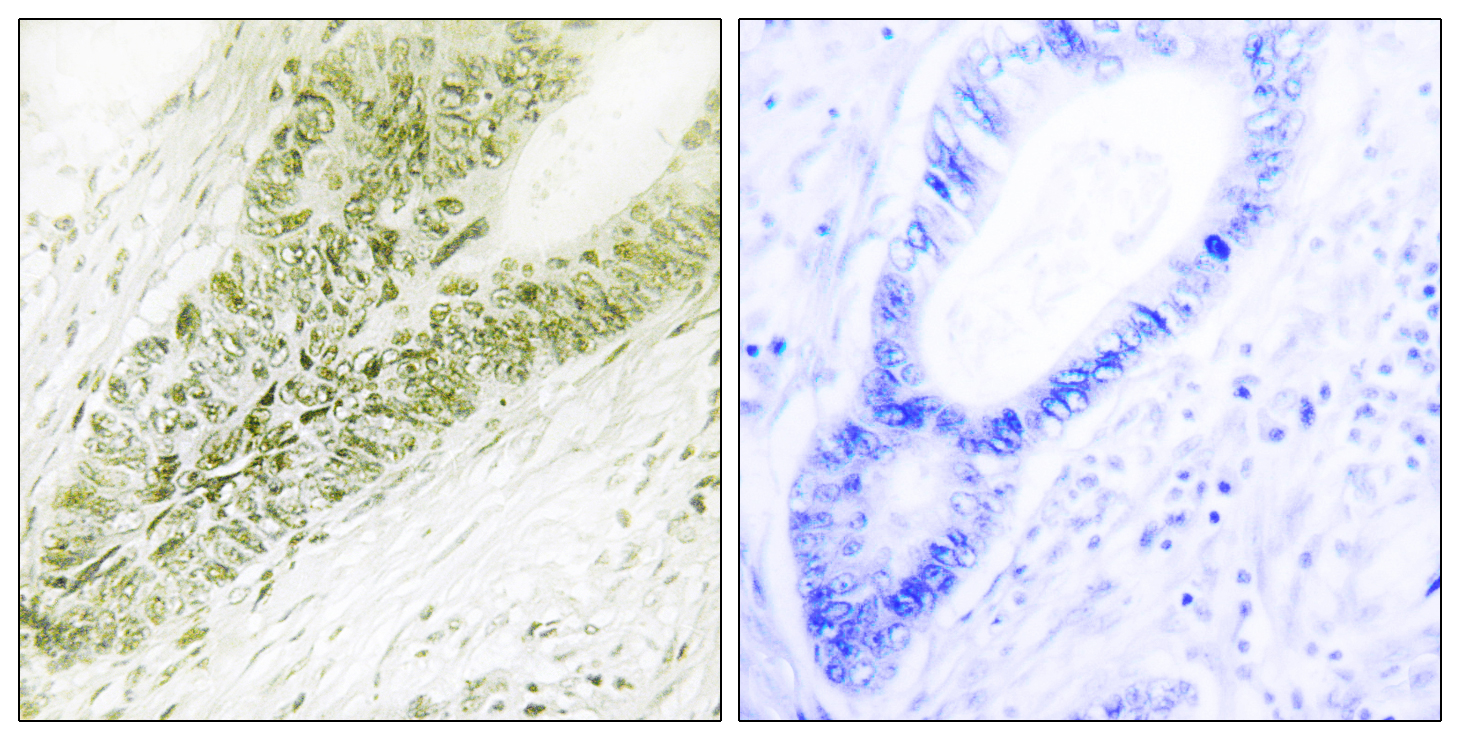UBN-1 Polyclonal Antibody
- Catalog No.:YT4806
- Applications:WB;IHC;IF;ELISA
- Reactivity:Human;Mouse
- Target:
- UBN-1
- Gene Name:
- UBN1
- Protein Name:
- Ubinuclein-1
- Human Gene Id:
- 29855
- Human Swiss Prot No:
- Q9NPG3
- Mouse Gene Id:
- 170644
- Mouse Swiss Prot No:
- Q4G0F8
- Immunogen:
- The antiserum was produced against synthesized peptide derived from human Ubinuclein. AA range:161-210
- Specificity:
- UBN-1 Polyclonal Antibody detects endogenous levels of UBN-1 protein.
- Formulation:
- Liquid in PBS containing 50% glycerol, 0.5% BSA and 0.02% sodium azide.
- Source:
- Polyclonal, Rabbit,IgG
- Dilution:
- WB 1:500-2000 IHC 1:100 - 1:300. IF 1:200 - 1:1000. ELISA: 1:10000. Not yet tested in other applications.
- Purification:
- The antibody was affinity-purified from rabbit antiserum by affinity-chromatography using epitope-specific immunogen.
- Concentration:
- 1 mg/ml
- Storage Stability:
- -15°C to -25°C/1 year(Do not lower than -25°C)
- Other Name:
- UBN1;Ubinuclein-1;HIRA-binding protein;Protein VT4;Ubiquitously expressed nuclear protein
- Molecular Weight(Da):
- 122kD
- Background:
- function:Acts as a novel regulator of senescence. Involved in the formation of senescence-associated heterochromatin foci (SAHF), which represses expression of proliferation-promoting genes. Binds to proliferation-promoting genes. May be required for replication-independent chromatin assembly.,similarity:Belongs to the ubinuclein family.,subcellular location:Localized as a nuclear speckled-like pattern in proliferating primary fibroblasts. Colocalizes with HIRA, PML and SP100 in PML bodies of senescent cells. Colocalizes with TJP1 and CLDN1. Detected along the upper granular cell layer of epidermis. When overexpressed, accumulates in the nucleus in cells showing defective cytokinesis.,subunit:Component of a complex that includes at least ASF1A, CABIN1, HIRA, histone H3.3 and UBN1. Interacts with Epstein-Barr virus BZLF1. Interacts with HIRA (via WD repeat domain); the interaction is direct. Interacts with ASF1A, CEBPA, TJP1, TJP2 and TJP3.,tissue specificity:Ubiquitous. Also expressed in numerous tumors and cancer cell lines.,
- Function:
- function:Acts as a novel regulator of senescence. Involved in the formation of senescence-associated heterochromatin foci (SAHF), which represses expression of proliferation-promoting genes. Binds to proliferation-promoting genes. May be required for replication-independent chromatin assembly.,similarity:Belongs to the ubinuclein family.,subcellular location:Localized as a nuclear speckled-like pattern in proliferating primary fibroblasts. Colocalizes with HIRA, PML and SP100 in PML bodies of senescent cells. Colocalizes with TJP1 and CLDN1. Detected along the upper granular cell layer of epidermis. When overexpressed, accumulates in the nucleus in cells showing defective cytokinesis.,subunit:Component of a complex that includes at least ASF1A, CABIN1, HIRA, histone H3.3 and UBN1. Interacts with Epstein-Barr virus BZLF1. Interacts with HIRA (via WD repeat domain); the interaction is dire
- Subcellular Location:
- Nucleus, nucleoplasm. Nucleus, PML body. Cell junction, tight junction. Localized as a nuclear speckled-like pattern in proliferating primary fibroblasts. Colocalizes with HIRA, PML and SP100 in PML bodies of senescent cells. Colocalizes with TJP1 and CLDN1. Detected along the upper granular cell layer of epidermis. When overexpressed, accumulates in the nucleus in cells showing defective cytokinesis.
- Expression:
- Ubiquitous. Also expressed in numerous tumors and cancer cell lines.
- June 19-2018
- WESTERN IMMUNOBLOTTING PROTOCOL
- June 19-2018
- IMMUNOHISTOCHEMISTRY-PARAFFIN PROTOCOL
- June 19-2018
- IMMUNOFLUORESCENCE PROTOCOL
- September 08-2020
- FLOW-CYTOMEYRT-PROTOCOL
- May 20-2022
- Cell-Based ELISA│解您多样本WB检测之困扰
- July 13-2018
- CELL-BASED-ELISA-PROTOCOL-FOR-ACETYL-PROTEIN
- July 13-2018
- CELL-BASED-ELISA-PROTOCOL-FOR-PHOSPHO-PROTEIN
- July 13-2018
- Antibody-FAQs
- Products Images

- Immunofluorescence analysis of A549 cells, using Ubinuclein Antibody. The picture on the right is blocked with the synthesized peptide.

- Immunohistochemistry analysis of paraffin-embedded human colon carcinoma tissue, using Ubinuclein Antibody. The picture on the right is blocked with the synthesized peptide.



